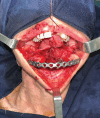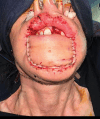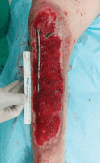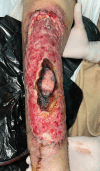Twenty Years of "Occasional" Reconstructive Microsurgery: A Retrospective Review of a Single Surgeon's Experience
- PMID: 40510433
- PMCID: PMC12160735
- DOI: 10.1097/GOX.0000000000006832
Twenty Years of "Occasional" Reconstructive Microsurgery: A Retrospective Review of a Single Surgeon's Experience
Abstract
Background: Microsurgical free flap reconstruction is a highly technical surgery, usually performed in high-volume specialized centers. During the last 20 years, we had to perform occasional microsurgical reconstructions in our plastic surgery department where general and aesthetic plastic surgery is the main activity. The aim of the study was to review the results of our microsurgical activity and compare it with the results published by high-volume microsurgical centers.
Methods: We retrospectively reviewed all our microsurgical free flap reconstructions from 2004 to 2024. We collected from the files all the data concerning demographics, indications, flaps used, technical details, complications, and final outcomes.
Results: Seventy-one patients were included in the study, with a total of 77 flaps. Patients' age ranged from 7 to 82 years. The operative site was the head and neck in 66 cases, the lower limb in 9 cases, and the abdominal wall in 2 cases. The most frequently used flaps were the latissimus dorsi flap (24 flaps), the radial forearm flap (23 flaps), and the fibula flap (16 flaps). Anastomoses were done mainly under loupe magnification. Ten flaps presented signs of vascular compromise. Salvage rate after confirmed vascular thrombosis was 60%. A total of 4 flaps were lost (94.8% success rate).
Conclusions: Provided that some precautions are respected, "occasional microsurgery" can have success rates comparable to high-volume microsurgery centers. It can save lives and improve the patients' quality of life, and it does not prevent the surgeon from pursuing a normal general and aesthetic plastic surgery career.
Copyright © 2025 The Author. Published by Wolters Kluwer Health, Inc. on behalf of The American Society of Plastic Surgeons.
Conflict of interest statement
The author has no financial interest to declare in relation to the content of this article.
Figures










Similar articles
-
Free Latissimus Dorsi Flaps in Head and Neck Reconstruction at a Modern High-Volume Microsurgery Center.J Reconstr Microsurg. 2025 May;41(4):361-368. doi: 10.1055/a-2384-8376. Epub 2024 Aug 12. J Reconstr Microsurg. 2025. PMID: 39134047
-
Free flap head and neck microsurgery with VITOMⓇ 3D: Surgical outcomes and surgeon's perspective.Auris Nasus Larynx. 2021 Jun;48(3):464-470. doi: 10.1016/j.anl.2020.09.010. Epub 2020 Sep 25. Auris Nasus Larynx. 2021. PMID: 32988665
-
Matched Comparison of Microsurgical Anastomoses Performed with Loupe Magnification versus Operating Microscope in Traumatic Lower Extremity Reconstruction.Plast Reconstr Surg. 2020 Jan;145(1):235-240. doi: 10.1097/PRS.0000000000006381. Plast Reconstr Surg. 2020. PMID: 31609285
-
Interdisciplinary aspects of abdominal and plastic surgery - what does the (abdominal) surgeon need to know?Innov Surg Sci. 2023 Sep 21;8(2):103-112. doi: 10.1515/iss-2023-0042. eCollection 2023 Jun. Innov Surg Sci. 2023. PMID: 38058780 Free PMC article. Review.
-
Ortho-oncoplastic surgery in foot and ankle: A narrative overview on reconstruction of soft-tissue defects after oncologic resections.Microsurgery. 2024 May;44(4):e31168. doi: 10.1002/micr.31168. Microsurgery. 2024. PMID: 38549392 Review.
References
LinkOut - more resources
Full Text Sources
